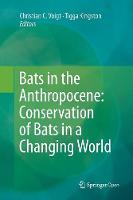Chemical Signals in Vertebrates 13
 -15%
portes grátis
-15%
portes grátis
Chemical Signals in Vertebrates 13
Ferkin, Michael H.; Goodwin, Thomas E.; Schulte, Bruce A.
Springer International Publishing AG
03/2019
536
Mole
Inglês
9783319793757
15 a 20 dias
1139
Descrição não disponível.
Are Mammals Just Furry Bugs with Fewer Legs? Convergences in Mammalian and Insect Chemical Ecology.- Chemical Signals in Vertebrates 13: Where We Stand and What Might Be Next.- Assessing the Role of Olfactory Cues in the Early Life History of Coral Reef Fish: Current Methods and Future Directions.- A Small Expose on Bovine Pheromones - with Special Reference to Modifications of the Reproductive Cycle.- Coding of Group Odor in the Subcaudal Gland Secretion of the European Badger Meles meles: Chemical Composition and Pouch Microbiota.- The Role of Bacteria in Chemical Signals of Elephant Musth: Proximate Causes and Biochemical Pathways.- Age-related Variation in the Scent Pouch Bacterial Communities of Striped Hyenas (Hyaena hyaena).- Bacterial Communities Associated with Junco Preen Glands: Preliminary Ramifications for Chemical Signaling.- Age-Related Effects on Individual Discrimination among Meadow Voles, Microtus pennsylvanicus.- Putative Pheromone of the Indian Crestless Porcupine, Hystrix brachyuran.- Chemical Cues, Hibernation and Reproduction in Female Short-Beaked Echidnas (Tachyglossus aculeatus setosus): Implications for Sexual Conflict.- Chemical Analyses Reveal Family Specific Nest Odor Profiles in Zebra Finches (Taeniopygia guttata): A Pilot Study.- Exploring the Use of Olfactory Cues in Non-Social Context in Zebra Finches (Taeniopygia guttata).- Variation in Urinary Amino Acids in the Mozambique Tilapia: A Potential Signal of Dominance or Individuality?.- A Low Phytoestrogen Diet Reduces the Proceptivity but not the Attractivity of Meadow Voles (Microtus pennsylvanicus).- Chemical communication in Indian Blackbuck (Antelope cervicapra L) with Special Reference to Dominance.- Asian Elephant Reflections: Chirality Counts.- Detection of Fish and Newt Kairomones by Ovipositing Mosquitoes.- Evolutionary Aspects of the Use of Predator Odors in Antipredator Behaviors of Lumholtz's Tree-kangaroos (Dendrolagus lumholtzi).- Small Emissions with Major Consequences: Specialized Malodorous Defenses in Birds.- A Review of Chemical Defense in Poison Frogs (Dendrobatidae): Ecology, Pharmacokinetics and Autoresistance.- Semiochemicals in Anurans: Testing different Categories with one Poison Frog Species.- Chemical Communication in Archaic New Zealand Frogs.- Chemical Signals in Giant Panda Urine (Ailuropoda melanoleuca).- Semiochemical Communication in Dogs in the Context of Reproductive Behavior.- Hormonal and Behavioral Responses to Odor Cues in Zoo-housed African Painted Dogs (Lycaon pictus).- Responses to Domestic Cat Chemical Signals in the House Mouse are Modulated by Early Olfactory Experience.- Does Deconvolution Help to Disentangle the Complexities of Mammal Odors?.- Guidelines for Collecting and Extracting Avian Odors in a Remote Field: Case Study of a Subantarctic Seabird.- Pair-specific Scents in African Wild Dogs, Lycaon pictus, and an Example of a Potential Method to Identify Signals within Complex Mixtures.- Automated headspace solid-phase microextraction of urinary VOCs from eleven maned wolves (Chrysocyon brachyurus): a recursive workflow for GC-MS analysis.- Learning and Applications of Chemical Signals in Vertebrates for Human-Wildlife Conflict Mitigation.- An Experimental Test of the Effect of Diet on Preen Wax Composition in New Zealand Silvereyes (Zosterops lateralis).
Este título pertence ao(s) assunto(s) indicados(s). Para ver outros títulos clique no assunto desejado.
Chemical Cues;Chemical Ecology;Neuroethology;Pheromonal signaling;Semiochemical Communication;Model vertebrates
Are Mammals Just Furry Bugs with Fewer Legs? Convergences in Mammalian and Insect Chemical Ecology.- Chemical Signals in Vertebrates 13: Where We Stand and What Might Be Next.- Assessing the Role of Olfactory Cues in the Early Life History of Coral Reef Fish: Current Methods and Future Directions.- A Small Expose on Bovine Pheromones - with Special Reference to Modifications of the Reproductive Cycle.- Coding of Group Odor in the Subcaudal Gland Secretion of the European Badger Meles meles: Chemical Composition and Pouch Microbiota.- The Role of Bacteria in Chemical Signals of Elephant Musth: Proximate Causes and Biochemical Pathways.- Age-related Variation in the Scent Pouch Bacterial Communities of Striped Hyenas (Hyaena hyaena).- Bacterial Communities Associated with Junco Preen Glands: Preliminary Ramifications for Chemical Signaling.- Age-Related Effects on Individual Discrimination among Meadow Voles, Microtus pennsylvanicus.- Putative Pheromone of the Indian Crestless Porcupine, Hystrix brachyuran.- Chemical Cues, Hibernation and Reproduction in Female Short-Beaked Echidnas (Tachyglossus aculeatus setosus): Implications for Sexual Conflict.- Chemical Analyses Reveal Family Specific Nest Odor Profiles in Zebra Finches (Taeniopygia guttata): A Pilot Study.- Exploring the Use of Olfactory Cues in Non-Social Context in Zebra Finches (Taeniopygia guttata).- Variation in Urinary Amino Acids in the Mozambique Tilapia: A Potential Signal of Dominance or Individuality?.- A Low Phytoestrogen Diet Reduces the Proceptivity but not the Attractivity of Meadow Voles (Microtus pennsylvanicus).- Chemical communication in Indian Blackbuck (Antelope cervicapra L) with Special Reference to Dominance.- Asian Elephant Reflections: Chirality Counts.- Detection of Fish and Newt Kairomones by Ovipositing Mosquitoes.- Evolutionary Aspects of the Use of Predator Odors in Antipredator Behaviors of Lumholtz's Tree-kangaroos (Dendrolagus lumholtzi).- Small Emissions with Major Consequences: Specialized Malodorous Defenses in Birds.- A Review of Chemical Defense in Poison Frogs (Dendrobatidae): Ecology, Pharmacokinetics and Autoresistance.- Semiochemicals in Anurans: Testing different Categories with one Poison Frog Species.- Chemical Communication in Archaic New Zealand Frogs.- Chemical Signals in Giant Panda Urine (Ailuropoda melanoleuca).- Semiochemical Communication in Dogs in the Context of Reproductive Behavior.- Hormonal and Behavioral Responses to Odor Cues in Zoo-housed African Painted Dogs (Lycaon pictus).- Responses to Domestic Cat Chemical Signals in the House Mouse are Modulated by Early Olfactory Experience.- Does Deconvolution Help to Disentangle the Complexities of Mammal Odors?.- Guidelines for Collecting and Extracting Avian Odors in a Remote Field: Case Study of a Subantarctic Seabird.- Pair-specific Scents in African Wild Dogs, Lycaon pictus, and an Example of a Potential Method to Identify Signals within Complex Mixtures.- Automated headspace solid-phase microextraction of urinary VOCs from eleven maned wolves (Chrysocyon brachyurus): a recursive workflow for GC-MS analysis.- Learning and Applications of Chemical Signals in Vertebrates for Human-Wildlife Conflict Mitigation.- An Experimental Test of the Effect of Diet on Preen Wax Composition in New Zealand Silvereyes (Zosterops lateralis).
Este título pertence ao(s) assunto(s) indicados(s). Para ver outros títulos clique no assunto desejado.




